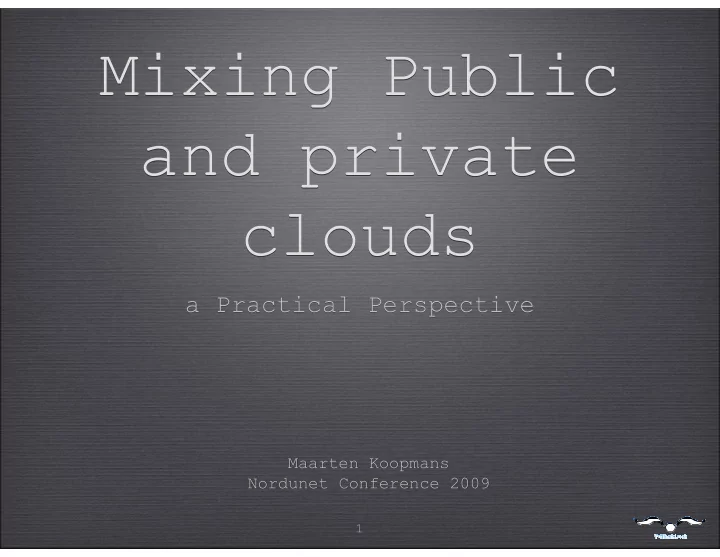

Mixing Public Mixing Public and private and private clouds clouds a Practical Perspective a Practical Perspective Maarten Koopmans Maarten Koopmans Nordunet Conference 2009 Nordunet Conference 2009 1 1
Who Who • ING Group -2002 • ING Group -2002 • SURFnet 2002-6 • SURFnet 2002-6 • ICTU (govt) 2006- • ICTU (govt) 2006- 8 8 • vrijheid.net • vrijheid.net 2008- 2008- • qtask.com • qtask.com 2 2 • ibeamsystems com • ibeamsystems com
What What is a cloud? Cost model Mixing private and public clouds Cloud and Grid Time left? Details, details… 3
Confusion 4
What is a Cloud (this is the UGLY slide with a lot of text) “Cloud Computing refers to both the applications delivered as services over the Internet and the hardware and systems software in the datacenters that provide those services. The services themselves have long been referred to as Software as a Service (SaaS), so we use that term. The datacenter hardware and software is what we will call a Cloud. When a Cloud is made available in a pay-as-you-go manner to the public, we call it a Public Cloud; the service being sold is Utility Computing. Current examples of public Utility Computing include Amazon Web Services, Google AppEngine, and Microsoft Azure. We use the term Private Cloud to refer to internal datacenters of a business or other organization that are not made available to the public. Thus, Cloud Computing is the sum of SaaS and Utility Computing, but does not normally include Private Clouds.” - Above the clouds paper, Berkeley 5
So... Pay as you go Public Utility computing + SaaS 6
Cost model No up front cost Pay per resource - GB storage, transfer, computing hour Discount when reserving e.g. virtual machines; drives total cost down for a small upfront investment 7
Cost model It’s OK to read sheets up fr It’s OK to read sheets up front. Just remember this one! ont. Just remember this one! Given a parallelizable computing job of N hours the cost of N computers running 1 hour equals the cost of 1 computer running N hours. 6 8
Cost Example 2 servers, 2 months, 50GB test data during development 8 servers, 2 months, 1TB data running time Monthly cost Total $162 $324 Development $786 $1572 Running time $1896 Total cost 9
Opportunities – part I (managers might want to make a note) Use public cloud model to model private clouds Cross-NREN clouds, scale up, cost goes down Public clouds, NREN service (like e.g. certificate service) 10
What have we done? 11
Google App Engine, Eucalyptus Two students: π π , MPI 12
Lessons learnt (time to make a note again) • Google App Engine is really well suited for certain web applications. Web applications. • Eucalyptus works, sort of. Promising, but the amount of time to get an infrastructure working on par with AWS is too much. Expect this to change within a year. 13
AWS, Eucalyptus Public Private Data storage Metadata, queues Your data, backup and restore 14
AWS, Eucalyptus Public Private Data storage, Metadata, queues image processing Process images in parallel 15
Lessons learnt • It’s all about resource sharing!!! • Credential management is key • Queues are everywhere, the rest may differ 16
Opportunities II • Resource sharing! • Credential management across clouds • Scaling out (private -> public) • Billing and metering in cross-NREN scaling out (this is a BIG one) 17
Cloud+Grid Or 18
Cloud+Grid Storage: as back end, public data sets or directly Buffer computing capacity - remember the computing hour equivalence rule! “a simpler solution than GRID” 19
Questions? Now…… or on to the details (or later...... maarten@vrijheid.net) 20
Cloud components Everything is there....... ...for a reason! 21
Cloud components Computing on demand (virtual machines), IP provisioning, block device service (persistent hard disks), load balancing and service monitoring Storage Service Simple large tables Queuing system Map-reduce 22
Simple Example within Amazon Image bundling S3 EC2 Virtual machine(s) Simple Storage Service Image booting EBS “Virtual Disk ” 23
Example data upload 24
Example: data restore 25
Example: data processing 26
Even more questions? Now or...... maarten@vrijheid.net 27
Recommend
More recommend